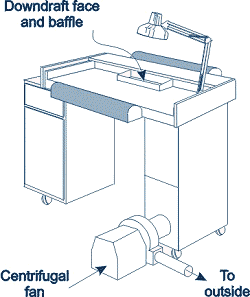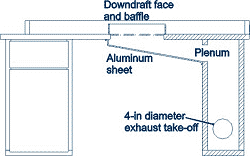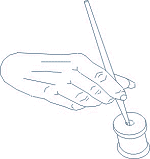Controlling Chemical Hazards During the Application of Artificial Fingernails
January 1999
DHHS (NIOSH) Publication Number 99-112

Hazard
Artificial fingernail products are made from many chemicals, but the main one in most of these products is ethyl methacrylate (EMA). In 1974 the U.S. Food and Drug Administration outlawed a similar chemical, methyl methacrylate (MMA), used in fingernail products. MMA was proven harmful to nail technicians and customers. However, both MMA and EMA can cause contact dermatitis, asthma, and allergies in the eyes and nose, all problems that nail technicians know about. Both can make the eyes, nose, and other mucous membranes sting, become red, and swell. Customers are at risk, too. Because it is often difficult to tell which chemical in a nail salon is causing a sensitivity or allergy, it is best to control your exposure before you become sensitized.
Controls
In the nail salon, to get rid of EMA in the air you breathe, you should apply artificial fingernails at a ventilated work table. It is also helpful to keep all bottles of fingernail liquid tightly capped. Finally, you should look at your work habits to see if they can be improved.
Ventilated Table
Researchers from the National Institute for Occupational Safety and Health (NIOSH) have found that a ventilation table protects the nail technician best against breathing EMA. The ventilated table is the most important engineering control for getting rid of EMA in the fingernail salon because the vented table places local exhaust ventilation close to the work area.
Place local exhaust ventilation as close to the EMA source as possible. Exhaust this air outdoors. Charcoal filters that allow the air to be used over again are not recommended because it is hard to know when the charcoal is full.
Build a ventilated table, or change a table you already own into a ventilated one (Figure 1). Ventilated table sizes will vary from nail salon to nail salon. Choose a wood for your ventilated table that will not soak up the chemicals. If the table acts like a sponge, it may actually expose you to the chemicals you want to avoid. A veneer-coated particle board works well for the table material.

Make a hole in the table top for an air intake (called the downdraft face). This downdraft face should be placed on the technician's side of the table. Cover the hole with a screen-like cover (or perforated plate) to prevent things from falling in.
The client's side of the table should be a little higher than the technician's side. This will allow the client's hands to hang over the downdraft face and be as close as possible to the local exhaust ventilation (Figure 2).

Make sure enough air blows through the table downdraft to get rid of the EMA. The amount of air exhausted depends on its speed as it moves through the downdraft face and on the size of the table opening. However, too much air rushing past the fingernails may cause the artificial nail product to crystallize.
An air speed of 620 feet per minute, directly above the 13- by 4-inch downdraft face works well. A 22-inch baffle should surround the downdraft face to pull the moving air closer to the client=s hands.
Different drying times are needed for different fingernail products and different application techniques. Although a stronger and larger airflow will collect more dust during filing and dry the color coat faster, a slower and lower airflow gives better results for the artificial fingernail product.
Choose an exhaust fan that can exhaust at least 250 cubic feet per minute of air and has 1/4-inch static pressure. A 1/8 horse power centrifugal fan should work well. To prevent fan noise from getting in the way of talk or client comfort, you can do one of three things: (1) buy a quiet fan, (2) put a cover over a noisier fan, or (3) buy an outdoor fan to be placed on an outside wall. The fan should have control settings. Use either a multi-speed or high-volume exhaust fan with a damper. You can find a fan supplier by looking in a directory called "Thomas Register of American Manufacturers." Look under the headings of "fans" or "fans, centrifugal." Your public library should have this directory. The fan supplier may be able to install your fan, as well as supply the duct work and other needed materials.
Provide enough makeup air to replace the exhausted air. If the makeup air is too weak, there will be negative pressure areas and perhaps drafts. The air intake, which pulls outdoor air inside, should not be placed near the building exhaust. If the exhaust and intake vents are too close, dirty air will be pulled back into the room.
Comfort fans should not blow directly on the downdraft face because the strong air movement can interfere with the exhaust airflow.
Keep Dispenser Bottles Closed
Use dispenser bottles that have small openings, only large enough for an application brush to enter. The bottle stoppers should be pressure sensitive. A dispenser bottle with a pressure-sensitive stopper and small opening will result in less evaporation of the fingernail liquid and, thus, will cut down on possible exposures to methacrylates (Figure 3).

Keep Dispenser Bottles Closed Change Your Work Habits
Nail technicians can also lower their exposures to these airborne chemicals by changing some of their work habits:
- EMA-soaked gauze pads should be placed in a sealed bag before being thrown in the trash can.
- Trash can liners should be changed daily.
- No more than the needed amount of fingernail liquid should be poured into the closed dispenser bottle.
- Nail technicians should wear personal protective clothing and glasses. When technicians remove artificial nails, chips of acrylic often fly off, creating a need for eye protection. In addition to safety glasses, technicians also should wear long sleeves and gloves to protect their skin from acrylic dust.
- Technicians should wash their hands, arms, and face with mild soap and water several times throughout the day to remove potentially irritating dust.
- Eating and drinking should not be allowed where artificial fingernails are applied or in other working areas. Methacrylates in nail dust can be carried accidently to the mouth or face on a cup or other food item, and this contact may cause a skin rash. Also, many other chemicals are used in a salon that could cause health problems if swallowed.
- Smoking should be banned for the entire salon because many of the chemicals in a beauty shop, including nail products, catch fire easily.
Acknowledgments
The principal contributors to this publication are Cheryl F. Estill, Amy B. Spencer, Jane B. McCammon, R. Leroy Mickelsen, Ova E. Johnston, Anne Votaw, and Jerome P. Flesch. The drawings are by Dick Carlson, Daniel Farwick, and Daniel Watkins. Desktop publishing was provided by Rosmarie T. Hagedorn and Susan Kaelin.
This document is in the public domain and may be freely copied or reprinted. NIOSH encourages all readers of this HAZARD CONTROLS to make it available to all interested employers and workers.
Controlling Chemical Hazards During the Application of Artificial Fingernails [PDF - 175.18 KB]
- Page last reviewed: June 6, 2014
- Page last updated: June 6, 2014
- Content source:
- National Institute for Occupational Safety and Health Education and Information Division


 ShareCompartir
ShareCompartir